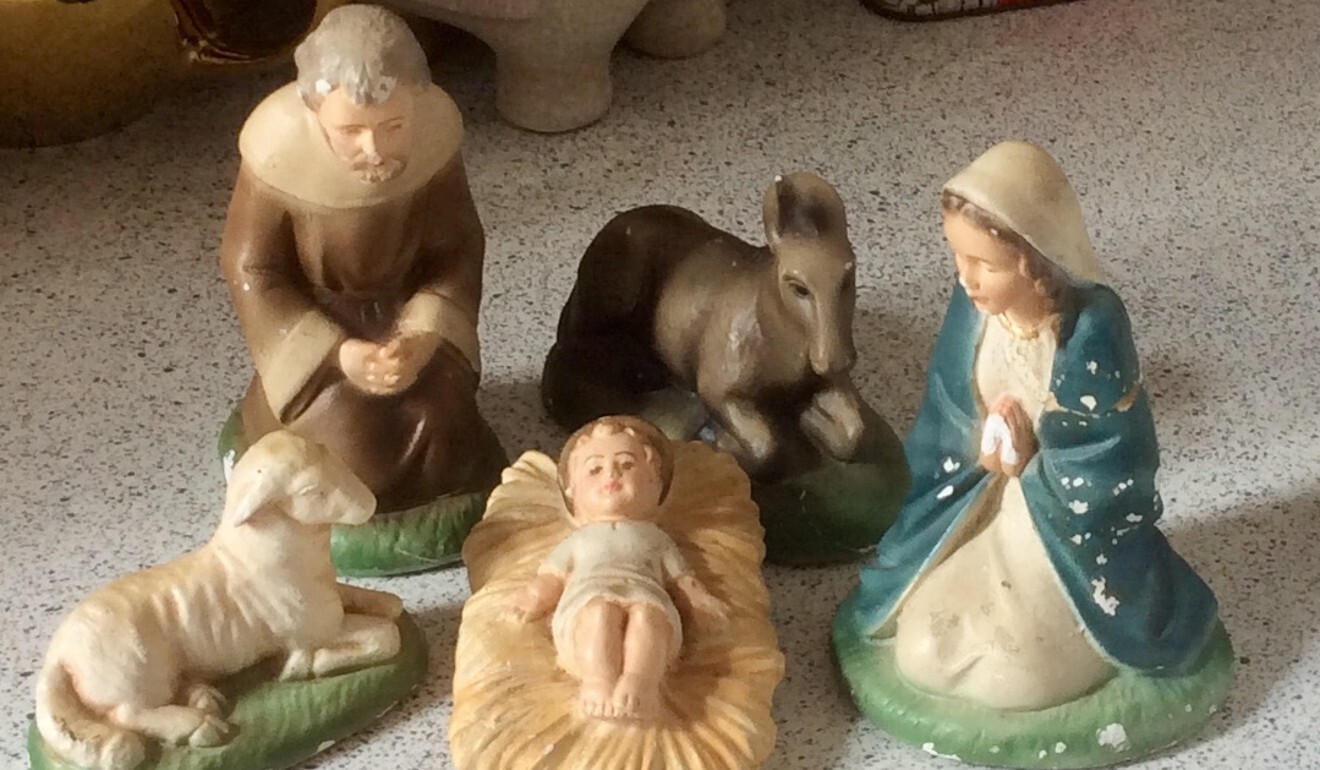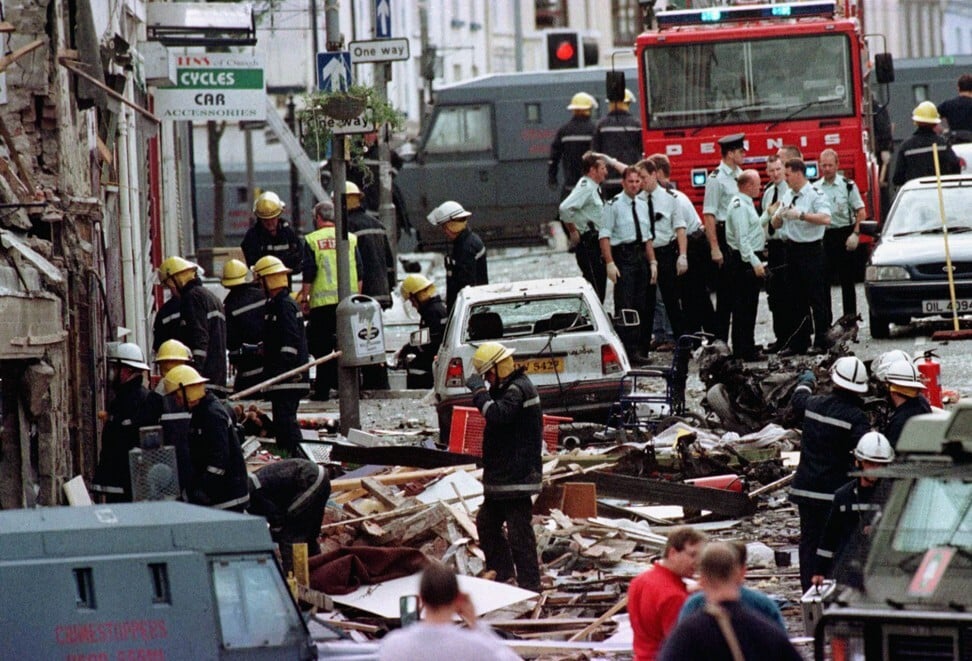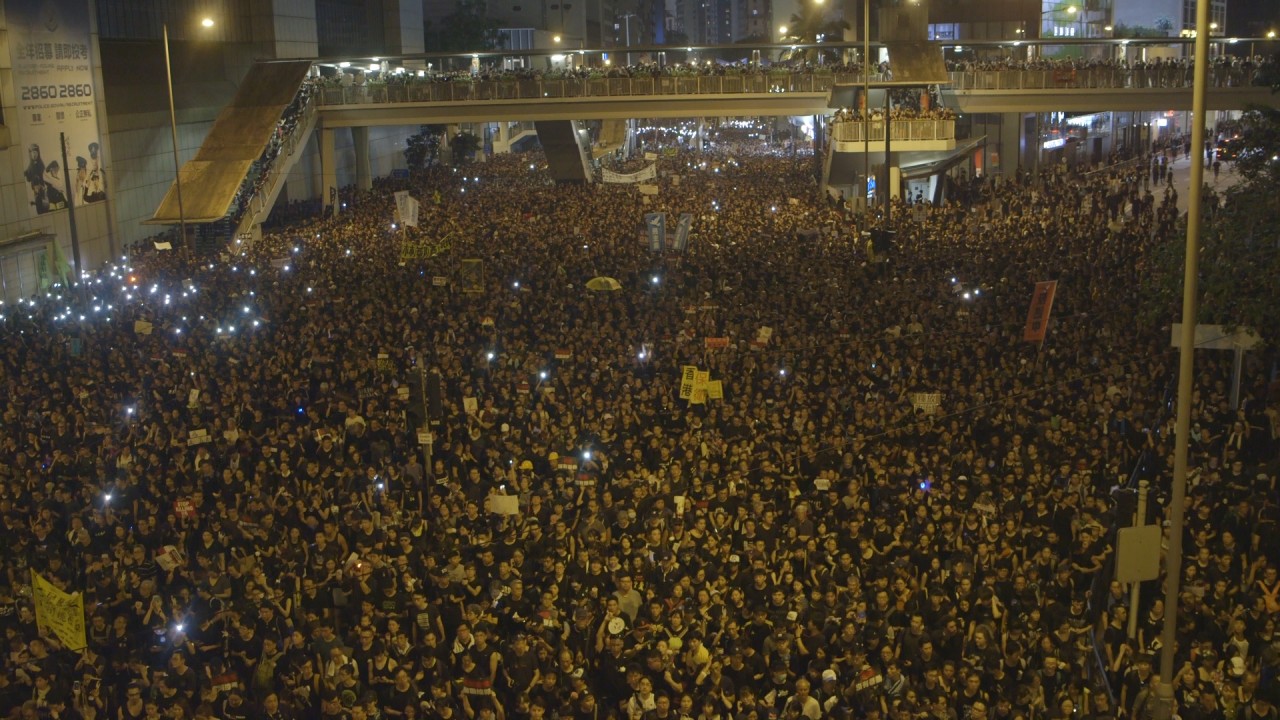
A writer delves into Christmases past and present and near and far as Hong Kong, once again, faces an unknown future
As a child, I used to think that Santa Claus lived in Hong Kong. The clue was written on the back of the plastic toys he left under the Christmas tree: “Made in Hong Kong”. Given that his postal address was the North Pole, this was puzzling but aspects of Christmas were often inexplicable.
My parents, for instance, moved house frequently yet Santa Claus always knew where we lived. Mysterious Hong Kong was part of the seasonal fairy tale. The rhyming words echoed Henny Penny and Chicken Licken and Goosey Loosey who thought the sky was falling.
One 1970s Christmas, the sky did fall in. We were then living in a tiny village, close to the border that divides Ireland into the North (British) and the South (Irish) although some of the South is more northerly than the North. As Santa Claus, my father could pull off magic but real life turned out to be harder. After years of promising we’d settle down, he’d got an architect to plan a house that was to be – the way he said it, you could hear the capitals – Our Home.
As the foundation stone was being laid, two Miraculous Medals were placed in it. I’ve often thought since about those Catholic emblems. You could say it was a miracle that we survived given that the house was built opposite a police station.
In Hong Kong’s national security law era, echoes of Ireland’s Troubles
The first bomb was small, which was lucky as there was no warning. I was 12 and the eldest of four children, the youngest of whom was two. Each succeeding explosion grew bigger along with the police station, which built deflecting blast walls and searchlights.
Bombing campaigns were worse in the darker days of midwinter. That dot of a village wasn’t exactly Belfast or Derry but, still, you waited and waited. We rehearsed running across the fields at the back to the house. Sometimes the bombers announced a Christmas truce; that was like being stood down for a week.
My father had been born in the west of Ireland – in Sligo, in the province of Connacht. Although he’d been to an Irish-speaking school in Galway, the only time I ever heard him use the language was on Christmas Day. While the turkey was cooling, he’d say: “Go mbeirimíd beo ar an am seo arís.” May we live to see this time next year. And two nights after he’d uttered that incantation in 1975, a car-bomb blew the roof off the house.
We were hiding under mattresses – there had been a warning but it was too dangerous to run – and it was as if the known world, inside and out, was splintering, a concussion of every sense including smell. (Bombs stink.)

No one died. Afterwards, the pulverised Christmas decorations were further ground into dust by passing firemen, British soldiers, a young carpenter who had worked in our house and who came in that night specially to help. The nativity set suffered casualties: two of the Three Wise Kings, plus a shepherd, didn’t make it. The Holy Family, however, came through scarred but intact. My father found us rented accommodation. Across the top of the first week of 1976, this 16-year-old wrote in her diary: “10th time that we’ve moved house”.
Acts of terrorism didn’t qualify for ordinary home insurance. British government policy was to pay compensation but only if you went back for more; and so we did. This phase went on for a decade, from 1971 to 1981. I still dream about that unsettled house. Is it Home if you always think you’re going to flee?
One night, my mother and I thought we’d try a yoga class in a town 30km away, and when we returned, the army had cordoned off the village. After the explosion – standing at the tape, a policeman and I were knocked into each other’s arms as we fell – the government provided a mobile home at the back of the house. The nativity set re-emerged for Christmas. About six months later, just as the Irish hunger strikes were beginning, the mobile home was flattened by another bomb. We never lived in that village again.
Northern Ireland’s ‘Troubles’ could show where Hong Kong is heading
When we’d set off to do our sun salutations, my mother and I hadn’t known we’d already spent the last night in Our Home. To this day, each time I leave the Kennedy Town flat I’ve been renting for almost 25 years – even if I’m only going downstairs to get milk from Wellcome – there’s a millisecond on the threshold: will I be back?
Sometimes the echo is so faint it’s like trying to remember what it is you feel you’ve forgotten – keys? pen? sunglasses? – while waiting for the lift. But it’s always stronger on cold, dark evenings and in the past 18 months, it’s been a consistent pulse. It is both a memory and a rehearsal, because one day I’ll have to go. This is not my home.
It’s not Santa Claus’ either. But during my first Hong Kong Christmas, in 1993, the harbour decorations, the trees, the shopping-mall choirs, the fake snow, the reindeer, the lights on the ferries made me think the city was making up for all the ambivalent Christmases I’d known before; and that not only the toys but an entire season of goodwill was Made in Hong Kong. If you think that an exaggerated response, consider the single fact that explosive devices, disguised as presents, had been hung on public Christmas trees in Northern Ireland.
Several times, gallivanting that first Christmas, I’d take the ferry back to Hong Kong Island at twilight, just as the windows were being lit up across the city. It was like sailing into a giant advent calendar. What was coming, however, wasn’t the baby Jesus but China. The days being counted down were to the handover at midnight on June 30, 1997. Nobody knew what lay behind those as-yet unopened doors.

Although I’d originally come “for a year”, the situation held appeal for someone home-schooled in impermanence. After my first Hong Kong Christmas, I went through a sequence of Christmases in places such as Laos and Cambodia, where I recalibrated how bad I thought the 1970s had been.
Travel’s lesson was to move on, in every sense. Then I’d return to Hong Kong where, even if you stood still, you were entering unknown territory while a new identity – from stamps to coins to flag – was created around you. Having experienced an enduring relic of colonialism, I was curious to see how a tweaked version might turn out. So I stayed.

On December 8, the battle for Hong Kong had begun, by which time Lane Crawford’s bakery had produced 160,000lbs of Siege Biscuits and 107,000lbs of Army Biscuits for the military authorities. When the colony fell on December 25, there were still 700 Christmas puddings in stock; but two of the staff, Cyril Lodge and Herbert Burson, who had come out from Home as sales assistants, had died on Christmas morning in the defence of Hong Kong. (A third, Fred Hall, was beheaded on Stanley Beach on October 29, 1943; he had worked in Lane Crawford’s butchery department.)
I know this because six years ago, Lane Crawford – founded in 1850 by a Mr Lane and a Mr Crawford and now owned by Peter Woo Kwong-ching – asked me to see what I could find out about its history. It wasn’t for a book or an exhibition. It was “a scoping exercise”, a short-term mission to assess if there was scope for any future projects.
For the next 10 weeks, I’d alternate between, say, the North-China Herald from 1860 (Lane Crawford had had a store in Shanghai), the 1890 Chronicle & Directory for the region, and the news in that day’s South China Morning Post. In the mess archive, there were stern memos about rowdyism (Christmas Eve 1905 had been particularly boisterous); the increased cost of running the lift (“Surely it can be no great hardship for healthy, able-bodied young men to walk down stairs”); over-consumption of aerated waters; and plague (“As the danger of infection from dead rats is now reduced to a very small degree, we must ask assistants to refrain from smoking more than is necessary”).

In the evenings, I’d go down to Admiralty, walking in an able-bodied way from Sheung Wan because the city was paralysed and buses from Kennedy Town – which wasn’t yet on the MTR – couldn’t get through. I’d chat to the students camped along Connaught Road Central. Inside designated tents, they did their homework, saying, “This is not a holiday! We should be studying!” It had the flavour of a stage set or petting zoo. In the early days, overseas visitors would say to me, “Let’s go and see the students.”
Although the police had initially gassed them – tear-bomb is the evocative Chinese phrase – and then disappeared, the students scrubbed the road clean of anti-police slogans. They were earnest, clueless, terrifying in their naivety. Sometimes I’d glimpse Hello Kitty paraphernalia, which, scribbling notes, I’d abbreviate as “HK backpacks”, “HK facecloths”, “HK hand fans”. And so I started to view it as the HK revolution, a mouthless cat unwisely poking a dragon.
The colonial flags and Union flags were baffling; I’d seen them at Hong Kong demonstrations before, carried by a few outliers. Now they seemed to be multiplying. I remembered a line written in Mr Crawford’s copperplate in the mess archive: “I desire now that the keys of the store etc should be never in the charge of anyone but a European.” At night, the words “Shangri-La” illuminated the sky from a nearby hotel.
By the time the police cleared the road on December 11, the tents were deserted. People asked, “What did they achieve?” Politically, the answer would have to wait. But sometimes I think they nudged me into my first Christmas in Northern Ireland since 1991.

I was always going back and forth – it was like being attached to a piece of implacable elastic – but I’d avoided that notch on the calendar for 23 years. “Is Hong Kong going to be another Northern Ireland?” family and friends kept asking about Occupy. I wasn’t sure. I watched the police clearance from a walkway and, the following morning, I began the journey back to the North.
My father was now in a care home in Tyrone. In 1998, he’d been in Omagh when a car-bomb had exploded, killing 29 people (31 if you counted, as my mother always did, unborn twins), the worst single-day death toll of the Northern Irish Troubles. He’d grown depressed about the past. He became so afraid he wouldn’t go outside. Now he was speechless and no longer knew me but we held hands in his room.
Beyond the window, the mid-afternoon landscape was unbelievably dark and wet. The bare hedges looked as if they’d been cast in iron. I read him stories from the Ulster Herald about cross-border sheep-rustling and turkey marts and school nativity plays; the Christmas ads seemed identical to 40 years ago.
On Christmas Day, I was in Belfast with my sister and brother. We’d just watched the film Man on Wire when the care home rang to say our father had become ill and was in an ambulance. The hospital was 140km away, in the town where, all those years ago, my mother and I had gone for our one-off yoga class. I knew that to get there we’d have to pass through the village where we’d once lived, past the police station, past the house my father never mentioned, even when he could still speak.

None of us can drive so we had to take a taxi. The driver was sympathetic. We chatted, a stream of empty talk. Whatever you say, say nothing: that’s a line people use in the North. But as the rural contours of Tyrone grew more familiar, the three passengers fell silent. Maybe the driver sensed the jangling of molecules around him because, just as he drove past our old house, he glanced from side to side in theatrical disbelief and remarked, “You have to laugh at these wee places, all built on one street. You have to think, who lives here? What do these people do with themselves?”
In the hospital, the doctors discussed medication. Our father, so waxen it looked as if the drip he was tethered to was draining away his existence. He wouldn’t live to see this time next year.
It took a while to find somewhere we could stay because, on that Irish Christmas night, there was no room in any inn. We thought we’d have to sleep on the hospital floor. In the end, a nice woman in the countryside, who’d intended to close her B&B for the week but forgot to black out the dates online, agreed to put us up. “You’re very lucky,” she said as we arrived, just before midnight. We knew that already.

03:02
Historic protest in Hong Kong prompts leader’s apology but no withdrawal of extradition bill
It’s unlikely I’ll ever feel that way here again. “This is not your fight,” a young local told me later, during a protest, though I preferred that to the comment someone else made: “In a few months, we will be as professional as you guys in Ireland.”
I thought of the young carpenter who’d helped board up our house that Christmas. He’d planted the bomb earlier, waited for it to go off, then walked through the wreckage offering assistance. After 12 years in prison, he was granted political asylum in the United States. He moved to Pearl River, New York; and so, 45 years later and thousands of miles in opposite directions from that border village, both of us get on with our Pearl River lives.
This Christmas, Hong Kong reminds me of a snow globe, the sort Santa Claus might leave under a tree even if it’s no longer labelled Made in Hong Kong. We’re sealed in. We get shaken by occasional viral flurries. We’re frozen. The conversations may be about future departures, about new homes in new countries, about BN(O) passports and the possibility of creating a different life in England. But for the time being, we’re all here together, going nowhere.
Still, I like to have my passport up to date (for an emergency, as my father would say, it was one of his favourite words) and my Irish one was about to expire. Ireland set up a Hong Kong consulate in 2014 and I dealt with consular official Janis Lee. I’d never visited before; the signs in Irish gave me a pang. I’d deliberately wrapped up that side of myself and buried it. When the past is another country it can feel irretrievable, even without a virus. You can lose your sense of place. But at that moment Janis Lee appeared. “I know you!” she cried. “I see you in the lift! We live in the same building!”
